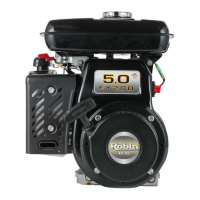10.
ROBIN
SOLID
STATE
IGNITION
ENGINE
('F.I.C.
and
P.I.T.)
r
10-1
FEATURES
Model
EYl5D
and
EY20D
can employ as option a pointless ignition system, called Solid State Ignition, whch is the circuit
breaker type ignition device, utilizing the power transistor as an element for controling eiectric current. There are two types
of this system, the one is outer coil type without pulser and is called
T.I.C.
(Transistor ignition circuit type) and the other
type has a built-in pulser coil and is called P.I.T. (Pulser transistor type). T.I.C. is a standard ignition system for
EY28D,
B.
Being different from the breaker point type ignition system, this brand-new system
is
completely free from such troubles as
startingup failure owing to dirty, burnt or oxidized point surface, lowering of ignition efficiency being caused by moisture,
rough
surface of breaker point and incorrect timing resultant from worn mechanical parts.
10-2
BASIC
THEORY
of
T.I.C.
(See
Fig.
59.)
T.I.C. (Transistor ignition type) consists ofthe flywheel and
ignition coil with built-in transistor; and its basic theory is as
-
follows:
I
1
11
I
Resister
T
Ignition
Coil
Revolution
of
the flywheel generates electricity on the
primary side of the ignition coil, and the electric cur-
rent
A
runs.
A
makes the power transistor
'ON"
and
the electric current
B
passes.
The flywheel goes round further, and at the time
of
ignition the electric current
C
runs, then the electric
current
D
runs
to
the signal transistor,
by
which the
electric current
B,
passing through the power transis-
tor,
is
abruptly cut; and as a result, the
high
voltage
electricity
is
generated on the secondary side of the
ignition coil and it sparks at the plug.
10-3
BASIC
THEORY
of
P.I.T.
(See
Fig.
60.)
P.1.T
@her ignition transistor type) consists of the igni-
tion coil,
P.I.T.
unit and flywheel; and its basic theory is
as
follows:
1) Revolution of the
flywheelgenerateselectricity
on the
primary side
of
the ignition coil, and the electric cur-
rent
A
runs.
A
makes the power transistor
"ON"
and
the electric current
B
passes.
2)
The flywheel goes round further, and at the time of
ignition, the pulser coil generates electricity, and the
electric current
C
runs;
and
SCR
becomes
"ON."
Then, the electric current
D
runs, by which the elec-
tric current
B
is cut abruptly, and as a result the high
voltage electricity is generated on the secondary side
of
the ignition coil and it sparks at the plug.
m
C
&
8
.-
v)
01
X
I"
Fig.
59
Fig.
60
-
46
-

